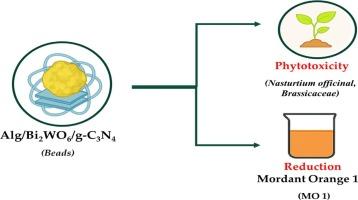“Efficient degradation of mordant Orange 1 dye using Alg/Bi2WO6/g-C3N4 composite and evaluation of Phytotoxicity for water treatment applications”
IF 8.5
1区 化学
Q1 BIOCHEMISTRY & MOLECULAR BIOLOGY
International Journal of Biological Macromolecules
Pub Date : 2025-10-23
DOI:10.1016/j.ijbiomac.2025.148413
引用次数: 0
Abstract
Industrial effluents containing synthetic dyes pose serious environmental risks due to their toxicity and persistence against conventional treatment methods. In this work, alginate-based composites incorporating Bi2WO6 and graphitic carbon nitride (g-C3N4) (Alg/Bi2WO6/g-C3N4) were fabricated and fully characterized (XRD, FTIR, SEM, EDS). Sodium alginate, a sustainable biopolymer, provides structural stability and facilitates catalyst recovery, while the synergistic combination of Bi2WO6 and g-C3N4 enhances catalytic performance. The catalytic activity was evaluated for the NaBH4 assisted degradation of Mordant Orange 1 (MO1). Kinetic analysis revealed a dose-dependent enhancement, with apparent rate constants increasing from 0.1321 min−1 (30 mg catalyst) to 0.2001 min−1 (45 mg) and 0.4168 min−1 (55 mg). The composite exhibited good mechanical robustness and reusability over several catalytic cycles. Phytotoxicity assays confirmed the environmental safety of the treated effluent: Alg/Bi2WO6/g-C3N4 promoted seed germination and root elongation without adverse effects, whereas pure Bi2WO6 displayed concentration dependent inhibition at 500 ppm. These results demonstrate that Alg/ Bi2WO6/g-C3N4 composites are efficient, reusable, and eco-friendly catalysts with strong potential for sustainable water purification.

Alg/Bi2WO6/g-C3N4复合材料高效降解媒染剂橙1染料及水处理应用的植物毒性评价
含合成染料的工业废水因其毒性和持久性而对传统处理方法构成严重的环境风险。本文制备了含有Bi2WO6和石墨氮化碳(g-C3N4) (Alg/Bi2WO6/g-C3N4)的藻酸盐基复合材料,并对其进行了XRD、FTIR、SEM、EDS等表征。海藻酸钠是一种可持续的生物聚合物,它提供了结构稳定性和促进催化剂回收,而Bi2WO6和g-C3N4的协同组合增强了催化性能。对NaBH4辅助降解媒染剂橙1 (MO1)的催化活性进行了评价。动力学分析显示了剂量依赖性增强,表观速率常数从0.1321 min−1 (30 mg催化剂)增加到0.2001 min−1 (45 mg)和0.4168 min−1 (55 mg催化剂)。该复合材料在多次催化循环中表现出良好的机械稳健性和可重复使用性。植物毒性试验证实了处理后的废水的环境安全性:Alg/Bi2WO6/g-C3N4促进种子萌发和根伸长而无副作用,而纯Bi2WO6在500 ppm时表现出浓度依赖性抑制作用。这些结果表明,Alg/ Bi2WO6/g-C3N4复合材料是一种高效、可重复使用的环保催化剂,具有很强的可持续水净化潜力。
本文章由计算机程序翻译,如有差异,请以英文原文为准。
求助全文
约1分钟内获得全文
求助全文
来源期刊
CiteScore
13.70
自引率
9.80%
发文量
2728
审稿时长
64 days
期刊介绍:
The International Journal of Biological Macromolecules is a well-established international journal dedicated to research on the chemical and biological aspects of natural macromolecules. Focusing on proteins, macromolecular carbohydrates, glycoproteins, proteoglycans, lignins, biological poly-acids, and nucleic acids, the journal presents the latest findings in molecular structure, properties, biological activities, interactions, modifications, and functional properties. Papers must offer new and novel insights, encompassing related model systems, structural conformational studies, theoretical developments, and analytical techniques. Each paper is required to primarily focus on at least one named biological macromolecule, reflected in the title, abstract, and text.

 求助内容:
求助内容: 应助结果提醒方式:
应助结果提醒方式:


